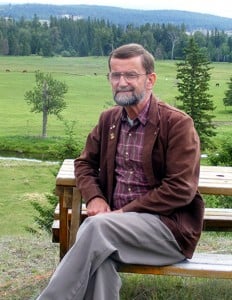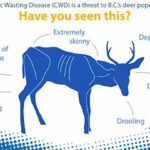Home »

Seeing Red Map reveals destruction of B.C. old growth forests
 “Perceptions,” by Gerry Warner
“Perceptions,” by Gerry Warner
Op-Ed Commentary
Time is running out.
Running out on what, you say? Something you’ve probably never thought about or only thought about very fleetingly when you were camping in the backcountry, hiking up Lakit Lookout or maybe even climbing Mt. Fisher. Or you could just be strolling up to Windy Bluff in the Community Forest or the Eager Hills in spring when the Balsam Root Sunflowers spread out around you like an endless yellow tapestry.
You take in a deep breath of that clean Kootenay air and look around and view one of the most impressive vistas in the world. The jagged Rockies to the east, the slightly less jagged Purcell Range to the west and far to the north you might even get a glimpse of the famed Bugaboo Range that Conrad Kain first climbed or maybe even the craggy pyramid of Mt. Assiniboine thrusting up in the north-east, the highest peak in the southern Rockies.
But look a little closer and you might not be so impressed by what you see.
It might even depress you a bit. Or make you angry. It certainly does me every time I view the heavy hand of industrial logging and the destruction it wreaks on the previously pristine forests of the Kootenays.
Once an endless green carpet, today the Kootenay forest is a patchwork of ugly clear-cut logging “blocks” as they are so elegantly called in the trade. Less than a century ago, vertiginous, green forests of Ponderosa Pine, Douglas Fir, Larch and Red Cedar covered the slopes providing a home for hundreds of animal, plant and grassland species that make up one of the richest biological landscapes anywhere on the planet and often compared to the Serengeti Valley of Africa. Oh, it’s still here, but it’s a damaged landscape and it’s being more damaged everyday by the very society you’d think would appreciate it the most. That’s us, the people of B.C. who remain largely indifferent to the primeval forests left to us.
But now we know just how little old growth is left thanks to a Prince George-based environmental group, Conservation North, that recently released a map they call the “Seeing Red Map.” And it’s easy to see why the group is seeing red!
After a painstaking year of acquiring digital maps from government sources and spending more than $4,200 to acquire the information, the group determined there’s only 415,000 hectares of productive old growth left in the province, an area only slightly bigger than Vancouver Island and a fraction the size of B.C.
You can see the map yourself in the Narwhal, a non-profit, award-winning, investigative journal that has tenaciously challenged the NDP government to make good on its “strategic review” of old growth in the province.
Pacific Wild creative director Geoff Campbell said the high-resolution map will “shock the heck” out of B.C. residents. “People around the world and even British Columbians have an idea of what B.C. is. It’s pristine, it’s wild. The true reality is that essentially all of B.C.’s old-growth forest has been eliminated, and all you need to do is to look at this map to see that,” Campbell said.
In a report to government last April, Registered Professional Foresters Al Gorley and Garry Merkel said there is a “widespread lack of confidence” in how the government is managing old growth in B.C. A “paradigm shift” is needed to recognize the biodiversity ancient forests provide in addition to environmental benefits such as delaying climate change by sequestering carbon, purifying the air, protecting watersheds and providing a nurturing environment for thousands of plant and animal species.
In September, Forests Minister Doug Donaldson responded with a two-year logging deferral on 372,739 hectares of old growth in the province. But critics were quick to point out that deferring logging was just delaying logging and the government response wasn’t in the sprit of its own report.
So, what’s it going to be? More “talk and log” while the government looks the other way and collects millions in tax revenue and the logging companies boost their profits? Or will there be a “paradigm shift” to more environmentally-friendly logging practices that will protect the benefits society gains from healthy forests. and the old growth that sustains them?
The government makes the rules, and so far, the NDP looks anything but green in how it’s managing our under-appreciated forests.
Photos submitted by Gerry Warner
– Gerry Warner is a retired journalist, who sees nothing wrong with logging as long as it’s done at a sustainable level.







